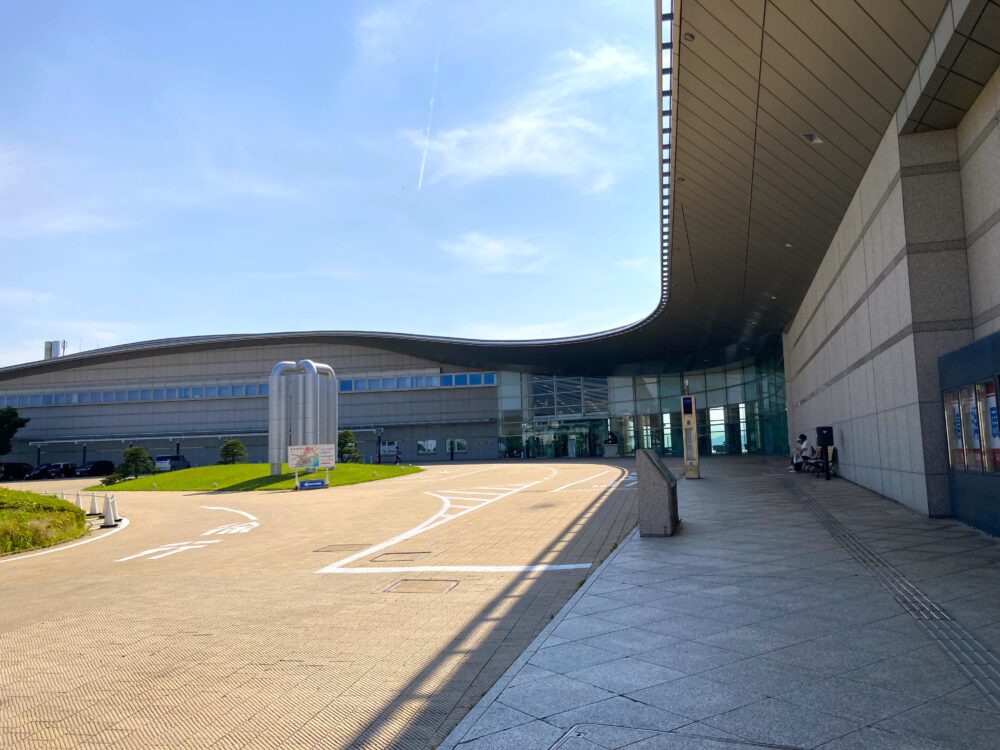
A Museum by Lake Shinji, Inspired by the Beauty of Water
The Shimane Art Museum, located on the eastern shore of Lake Shinji, is one of the largest museums in the San’in region.
Its main theme is “water”, and throughout the galleries, you’ll find stunning works depicting seas, waves, and serene waterside scenes.
From Claude Monet, master of Impressionism, to Gustave Courbet, pioneer of realism, and Japanese painter Shikanosuke Oka, the museum showcases masterpieces by both Western and Japanese artists who explored the beauty of water in their art.
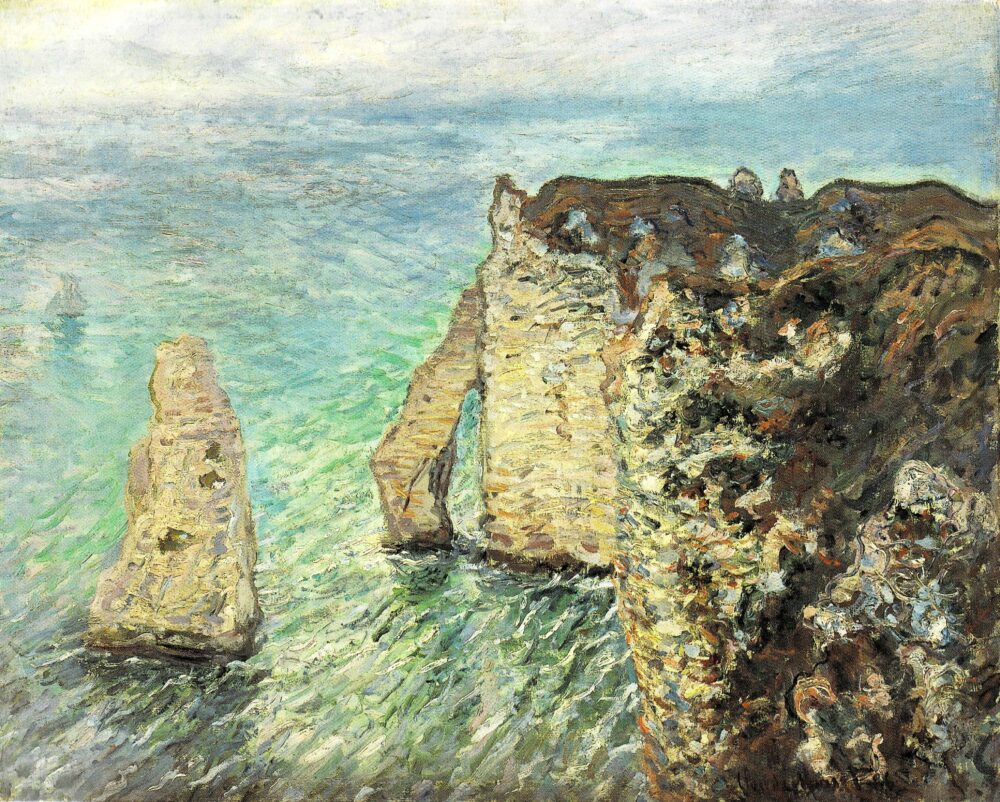
What makes this museum even more special is its setting.
The view of Lake Shinji seen through the windows beautifully connects with the artworks on display. It almost feels as if the paintings and the real landscape are one continuous scene.
Surrounded by calm waters and natural light, visitors can enjoy a truly relaxing art experience.
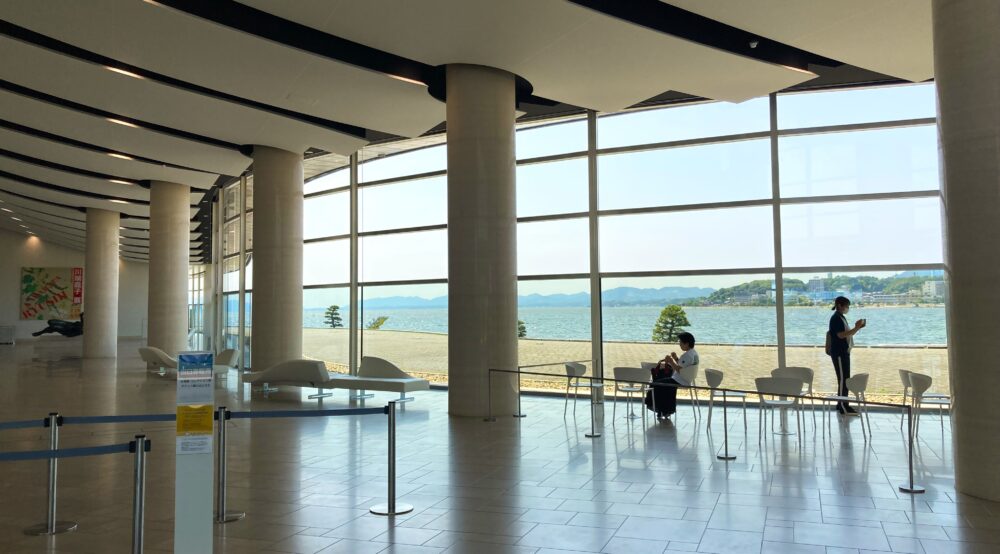
Hokusai’s Masterpieces on Display — A Must-See for Ukiyo-e Fans
The Shimane Art Museum also boasts an impressive Ukiyo-e collection, with a special focus on the works of Katsushika Hokusai.
The museum owns over 1,600 pieces by Hokusai, making it one of the most significant collections in Japan.
Inside the museum, you’ll find a permanent Hokusai Gallery, where visitors can admire a rotating selection of his most famous prints and other high-quality Ukiyo-e works.
Since the exhibits change regularly by season and theme, every visit offers something new.
Whether you’re a devoted Hokusai fan or just discovering Ukiyo-e for the first time, you’ll be captivated by his artistic world.
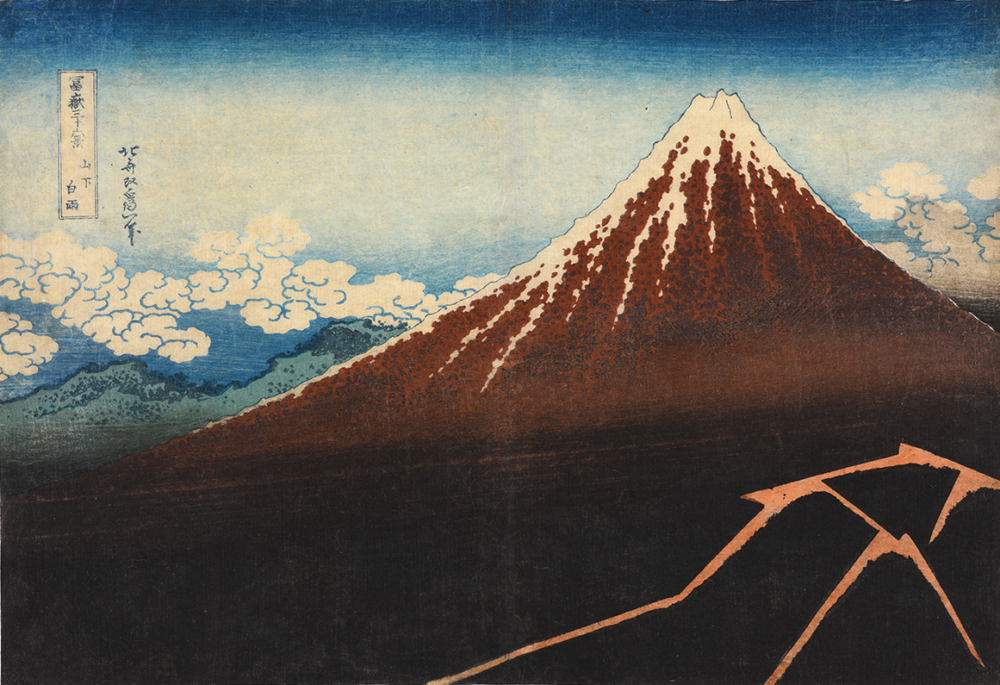
Paintings Inspired by “Water”
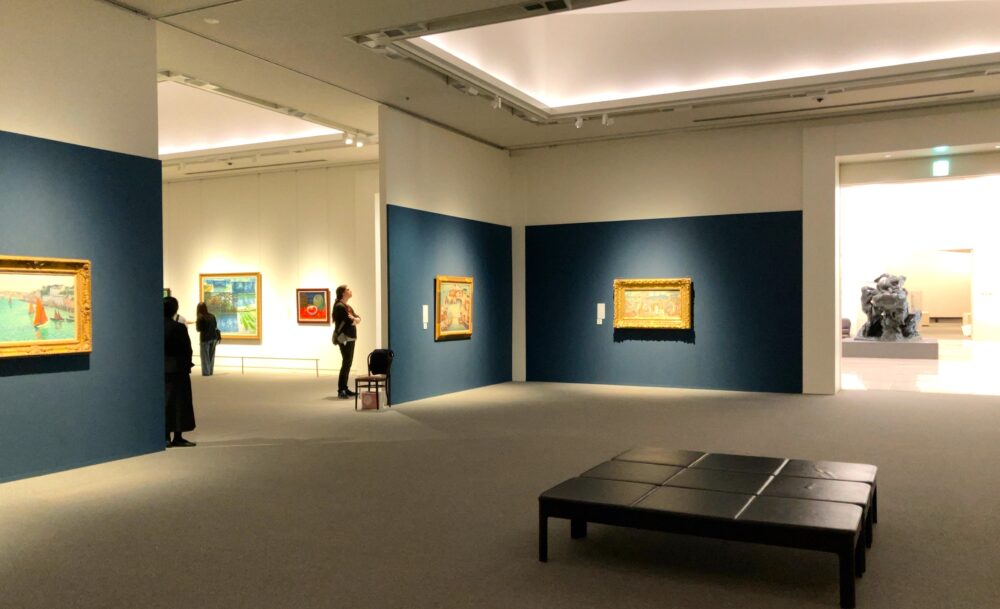
Located right on the shore of Lake Shinji, the Shimane Art Museum offers a perfect setting for its unique theme — water.
The museum’s collection features many works that capture scenes of the sea, rivers, and waterside landscapes, highlighting how artists from different eras have expressed the movement and tranquility of water.
Gentle ripples on a quiet lake, the salty breeze of the sea, and the soft light along a riverside—
being surrounded by such imagery makes it feel as if the water in the paintings connects seamlessly with the real world outside.
Here are a few recommended works from the museum’s “Water” collection to explore before your visit.
Each piece offers a glimpse into the artists’ fascination with water and nature.
Please note: exhibitions may change depending on the season.
Some of the artworks introduced here might not be on display.
For the latest exhibition schedule, check the official Shimane Art Museum website (The exhibit list is in Japanese only) before your visit.
Claude Monet
“The Rock Needle and the Porte d’Aval” (1886)

About This Work (Tap or Click to View)
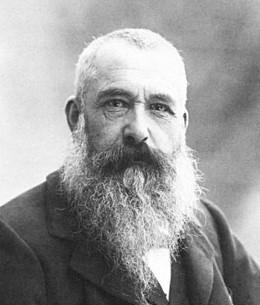
Monet’s Vision of Sea, Rock, and Light
Claude Monet, the master of Impressionism known for his famous series Water Lilies and Haystacks, was deeply fascinated by how light, weather, and time could transform a single scene.
He often painted the same subject repeatedly under different conditions, exploring how the world changes from moment to moment.
This painting, “The Rock Needle and the Porte d’Aval,” is one of the results of that exploration.
It depicts the natural sea arch at Étretat, located on the Normandy coast of France.
Between 1883 and 1886, Monet visited this area several times, capturing the dramatic cliffs and waves from various angles and in different lighting conditions.
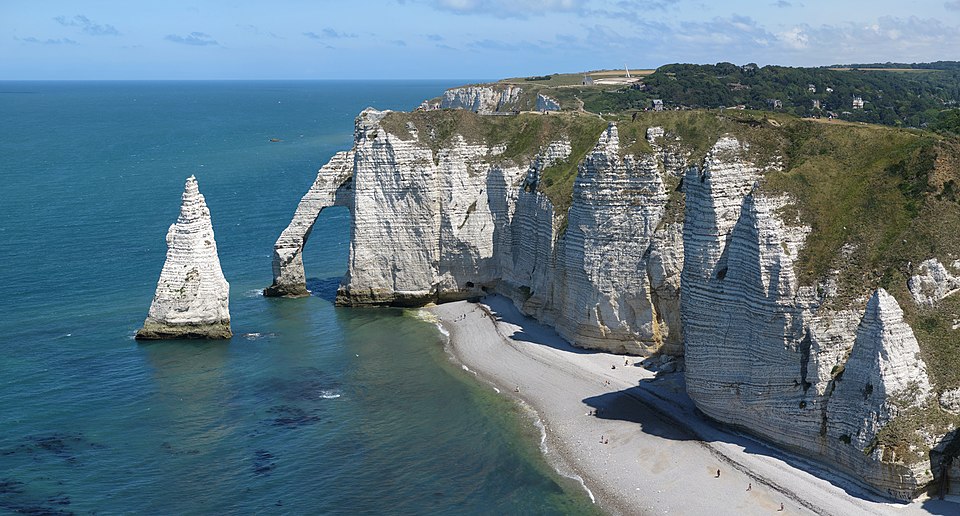
img: by Jörg Braukmann
Monet’s Love for the Normandy Coast
In this work, Monet skillfully expresses the rough texture of the rocks, the shimmering reflection of the sea, and the gentle rhythm of the waves.
His brushstrokes flow with the movement of wind and water, making viewers feel as if they’re standing right there on the cliffs overlooking the ocean.
Monet painted the Porte d’Aval from both east and west perspectives, and this canvas is considered one of several beautiful variations of the same motif.
Monet’s hometown, Le Havre, is also located in Normandy—a coastal city closely tied to his early memories.
For him, the sea and water were not just subjects but personal landscapes of the heart.
Alongside his later Water Lilies series, this seascape reflects the essence of Monet’s lifelong fascination with light and nature.
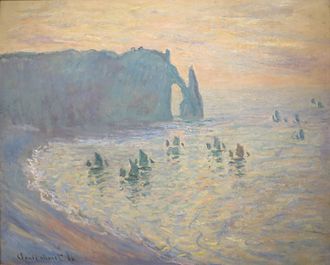
Collection of The Pushkin State Museum of Fine Arts
Gustave Courbet
“The Wave” (1869)
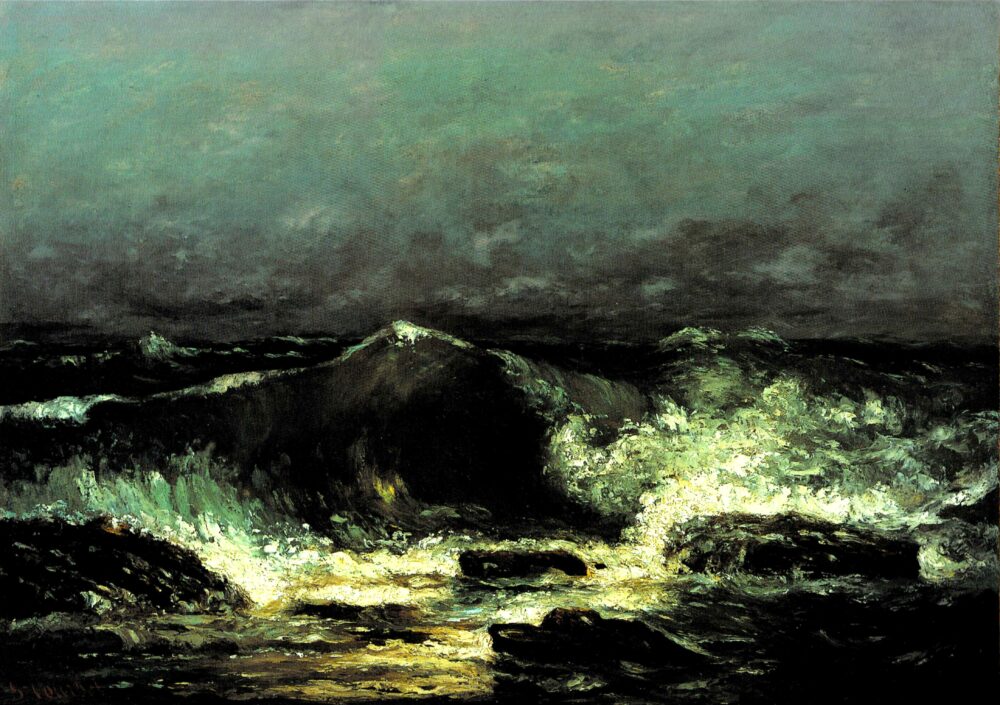
About This Work (Tap or Click to View)
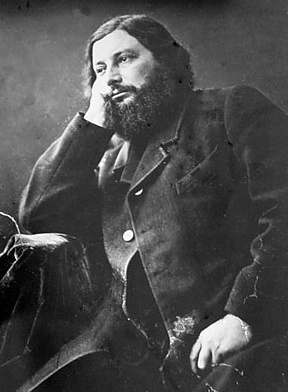
The Master of Realism
Capturing a single fleeting moment—today, we could do that with a smartphone in seconds.
But in the 19th century, that was nearly impossible. Early cameras required long exposure times, and something as dynamic as a crashing wave could never be sharply captured.
That’s what makes “The Wave” so remarkable.
Painted with bold strokes and thick textures, it feels almost alive—you can almost hear the sound of the surf. Courbet set out to paint what cameras of his time could not: the energy of a moment.
Painting Reality Through the Power of the Sea
Gustave Courbet, the French painter who led the Realist movement, rejected traditional subjects like mythology and history.
Instead, he painted “the world as it truly is.” His art was revolutionary for its time.
This painting is one of many seascapes Courbet created later in his career, especially during his 1869 stay in Étretat, on the coast of Normandy.
Here, he focused on the ocean itself—a force of nature full of motion and mystery.
In The Wave, the dark sea fills the canvas, its energy bursting against the rocks.
Thick layers of paint give the water a tactile, almost sculptural presence.
Most striking is Courbet’s use of white: the sharp white of the wave’s crest, the foamy white as it crashes against the rocks, and the softer white of calmer ripples in the foreground.
Each variation of white brings the waves to life, creating rhythm and movement within the dark sea and sky.
A Challenge to Photography
When Courbet painted this work, photography was beginning to emerge and challenge the role of painting.
Many artists wondered: If a photo can capture reality, what is the purpose of painting?
Courbet’s answer was clear—to express what a camera could never capture.
Waves are constantly moving and changing shape. To paint them was to embrace the impossible, and that challenge reflects Courbet’s rebellious spirit and devotion to Realism.
Among the Shimane Art Museum’s many “water-themed” works, The Wave stands out as one of its most powerful.
The waves seem frozen on the canvas yet somehow still rush toward you with incredible force.
When you see this masterpiece in person, you’ll truly feel “a moment of the sea”—alive, untamed, and eternal.
Paul Signac
“Rotterdam–The Steams” (1906)
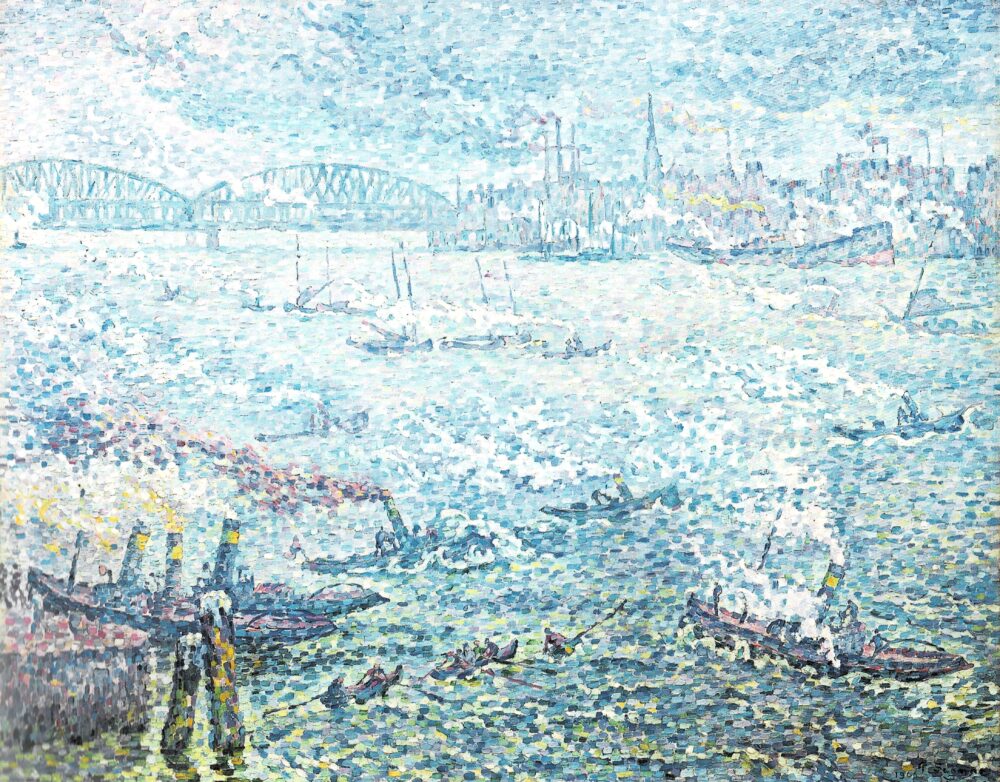
About This Work (Tap or Click to View)
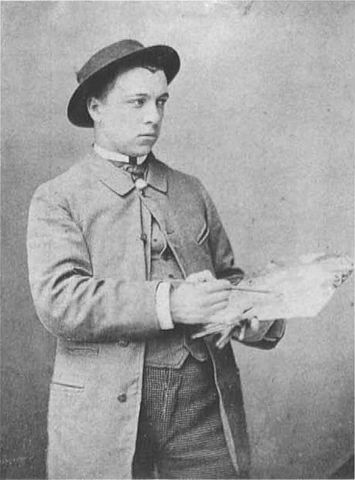
The Evolution of Pointillism
Paul Signac was one of the leading painters of the Neo-Impressionist movement, alongside Georges Seurat.
Both artists explored the use of tiny dots of color—pointillism—to create light, harmony, and movement on the canvas.
After Seurat’s early death in 1891, Signac continued to develop this painting style on his own, pushing it in bold new directions.
“Rotterdam – The Steams” was created during this period of transformation.
If you look closely, you’ll notice that the dots of color are larger than in his earlier works, creating a flatter and more decorative effect.
When compared to “In the Time of Harmony” (1893–1895, Montreuil City Hall), the difference is clear—the fine points have become broader color patches, and the composition feels more structured and rhythmic.
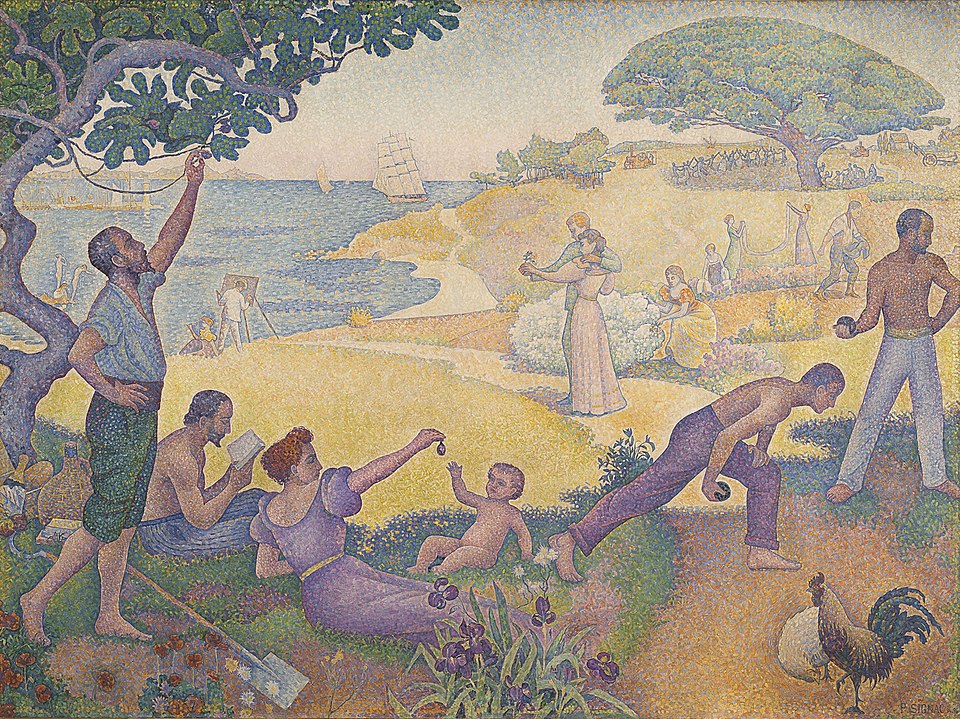
Collection of the Montreuil City Hall
A Painter Captivated by the Sea
Signac was deeply drawn to harbor towns and the beauty of water.
Throughout his travels across the Mediterranean, he painted countless scenes of boats, shimmering surfaces, and sunlit air, capturing the peaceful yet vibrant spirit of seaside life.
His affection for water is evident in “Rotterdam – The Steams.”
At first glance, it looks like a colorful mosaic—but look closer, and you can almost feel the moist air and transparent light of the harbor.
Even though the image is built from separate dots, Signac’s skillful use of color makes you sense the movement of wind and light across the scene.
By scattering colors across the canvas, he paints not only form but atmosphere itself.
It’s a quiet yet radiant masterpiece—perfectly suited to the Shimane Art Museum’s theme of “water.”
When you visit, take a moment to stand before this work and experience the air of the harbor painted in color.
Raoul Dufy
“Window Opening on Nice” (1928)
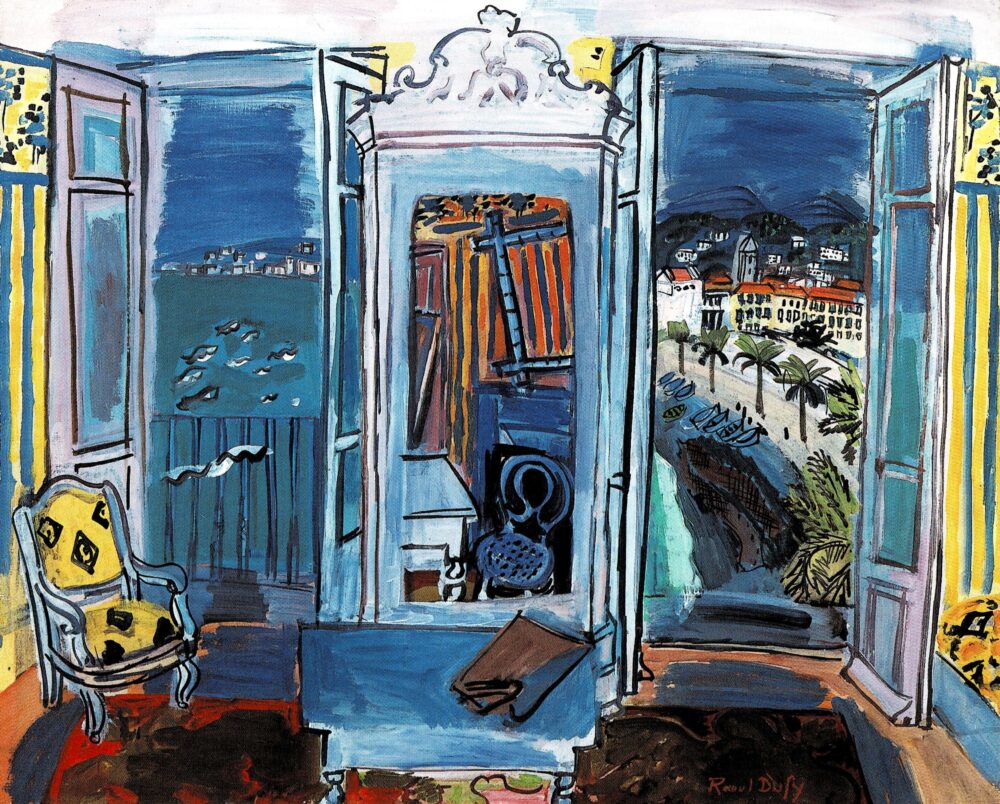
About This Work (Tap or Click to View)
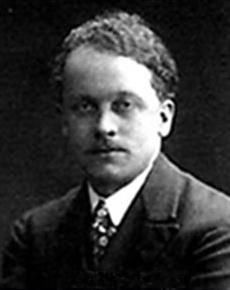
A Master of Color and Joy – The Fauvist Painter
Raoul Dufy was one of the leading artists of the Fauvist movement, alongside Henri Matisse.
Known for his vivid colors and rhythmic lines, Dufy’s paintings capture the lightness and energy of music itself.
“Window Opening on Nice” was painted in the 1920s, a period when Dufy had fully developed his personal style.
It’s a perfect example of his mature work—bold, bright, and full of life.
The cheerful interior, bathed in the sunlight of southern France, seems to carry the warmth and breezy charm of the Riviera.
The lively rhythm and brilliant palette make this painting a wonderful showcase of Dufy’s art.
The Memory of “Water” in Blue
One color defines Dufy’s work—blue.
In this painting, shades of blue fill the sky, sea, and walls, blending together in perfect harmony.
This use of blue creates a calm, refreshing atmosphere, as if the entire room is surrounded by the gentle sea breeze.
The reason for Dufy’s love of blue may lie in his hometown, Le Havre, a port city in northern France.
The same coastal town where Claude Monet spent part of his childhood, Le Havre’s changing light and seascape inspired generations of artists.
Dufy grew up in a musical family—his father played the organ, and his mother the violin.
As a young man, he spent hours copying works by Eugène Boudin, Monet’s mentor, at the local museum.
Surrounded by both sound and color, Dufy developed his unique sense of rhythm and harmony early on.
That’s why his paintings often feel bright, musical, and full of ocean air—a reflection of a painter who grew up by the water.
At the Shimane Art Museum, “Window Opening on Nice” brings this atmosphere to life.
You can almost feel the soft breeze through the window and hear the rhythm of color and light.
Be sure to experience this beautiful, blue-toned masterpiece in person.
Pierre Puvis de Chavannes
“The Childhood of Saint Genevieve” (1875)
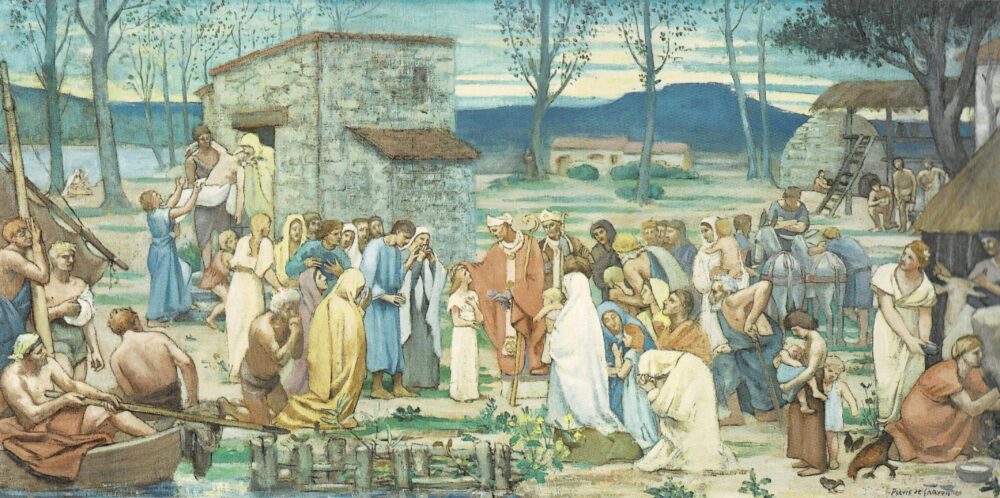
About This Work (Tap or Click to View)
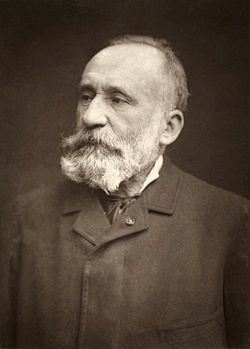
The Independent Vision of Puvis de Chavannes
Pierre Puvis de Chavannes was a French painter active from the mid to late 19th century.
While artists like Gustave Courbet and Claude Monet were leading major art movements, Puvis stood apart.
He didn’t belong to Romanticism, Realism, or Impressionism — instead, he followed his own unique artistic path.
At first glance, his works may look classical, but there’s something distinctly different about them.
That quiet strangeness is exactly what makes Puvis de Chavannes so fascinating.
Inspired by Fresco Painting
Puvis is best known for his large wall paintings, characterized by soft, muted tones and calm compositions.
This work, “The Childhood of Saint Genevieve”, is one of his important pieces.
It was created as a study for his mural series The Life of Saint Genevieve in the Panthéon in Paris.
In the center, Saint Germain of Auxerre recognizes the young Genevieve, who would later become the patron saint of Paris.
The villagers’ gentle gestures and expressions create a natural, harmonious rhythm across the composition.
Behind them, the flowing Seine River and soft hills add a poetic and peaceful atmosphere to this sacred scene.
Many people notice that Puvis’s paintings look a bit like frescoes — and that’s no coincidence.
During his 1854 trip to Italy, he was deeply influenced by Renaissance masters such as Piero della Francesca and Giotto.
However, rather than painting true frescoes, Puvis used a method called marouflage:
he painted on canvas and then adhered the canvas to a wall.
This allowed him to achieve the fresco-like appearance he admired, while keeping the flexibility of oil painting.
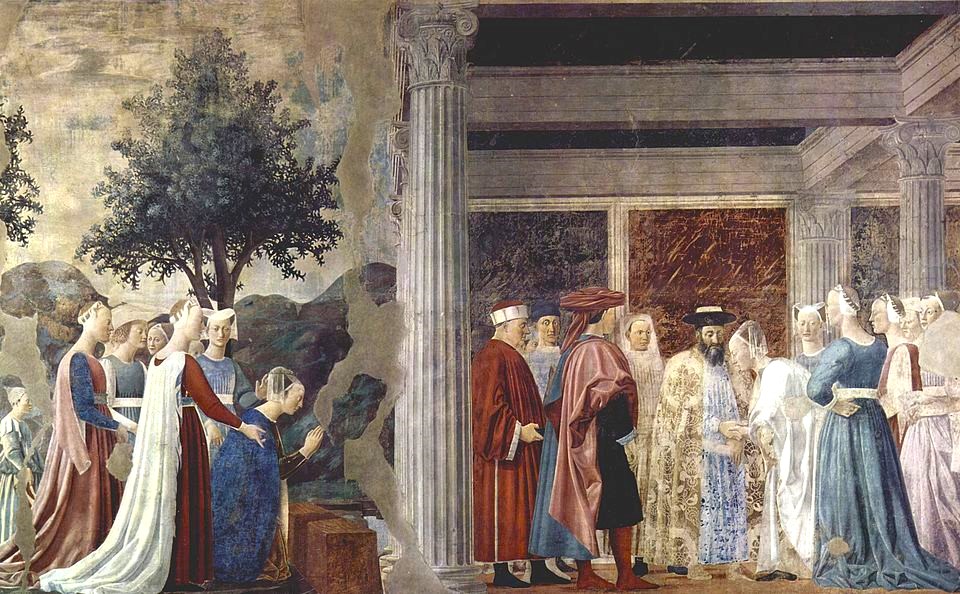
The Legend of the True Cross (1452–1466)
Beauty Found in Simplicity and Restraint
Traditional fresco techniques limited an artist’s ability to blend colors or apply multiple layers.
Artists had to rely on strong outlines and flat areas of color.
Puvis saw beauty in these very limitations.
His paintings feature clear contours and calm, balanced color fields.
What might have seemed like “restrictions” became essential elements of his visual language.
Even before the rise of Japonisme in Europe — when many Western artists were inspired by the flat lines of Japanese prints —
Puvis had already discovered the expressive power of outline and surface.
His subtle color gradations and delicate depth make his calm compositions quietly moving and deeply beautiful.
Although The Childhood of Saint Genevieve was originally a study, it stands as a complete and powerful work.
Its well-organized figures, gentle landscape, and still atmosphere make time seem to stand still.
Through this piece, we can sense Puvis de Chavannes’s unique vision —
an artist who looked to classical traditions while quietly imagining the art of the future.
When you visit the Shimane Art Museum, take a moment to experience the serene, timeless beauty of this work.
Must-See for Hokusai Fans!
The “Hokusai Gallery” at Shimane Art Museum
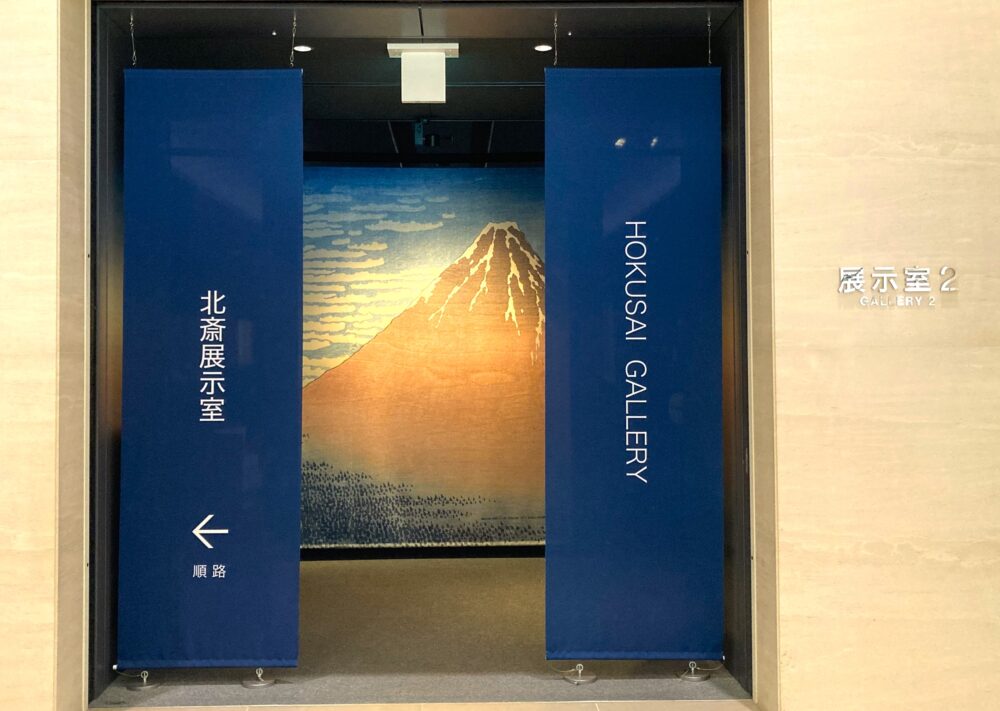
The Shimane Art Museum is known for its outstanding collection of ukiyo-e (Japanese woodblock prints).
It holds about 3,000 works, including more than 1,600 pieces by Katsushika Hokusai — one of the largest Hokusai collections in Japan.
For Hokusai enthusiasts, this museum is nothing short of a sacred destination.
In addition to its “Water-Themed Gallery,” the museum features a dedicated Hokusai Gallery,
where visitors can explore a rotating selection of high-quality ukiyo-e prints.
Around 40 works are displayed at any given time, and the lineup changes regularly with each season or exhibition theme.
That means every visit offers something new to discover.
Before your trip, check the official Shimane Art Museum website for the latest exhibition information —
since the displays change periodically throughout the year. (The exhibit list is in Japanese only)
▶ Shimane Art Museum Official Website
Katsushika Hokusai
“Thirty-Six Views of Mount Fuji”
When people think of Katsushika Hokusai, the “Thirty-Six Views of Mount Fuji” immediately comes to mind.
This famous series captures Japan’s sacred mountain from different locations and perspectives —
each print offering its own mood, light, and season.
The Shimane Art Museum owns 43 out of the 46 prints in the series,
including multiple versions of the same design with different printings (surimono),
for a total of 62 pieces.
One of the highlights is “Fine Wind, Clear Morning”, better known as “Red Fuji.”
The faint woodgrain pattern and the soft reddish-brown hue suggest that this is an early impression of the print.
Take a close look at the smooth gradient of color running from the mountain’s slopes to the forest below —
a perfect example of Hokusai’s sharp observation and refined sense of design.
Simple yet powerful, Red Fuji embodies the timeless beauty that has made Hokusai’s art famous around the world.
Utagawa Hiroshige
“The Fifty-Three Stations of the Tokaido”
The Hokusai Gallery at the Shimane Art Museum doesn’t just feature works by Katsushika Hokusai.
It also showcases masterpieces by other great ukiyo-e artists, including Utagawa Hiroshige.
One of the most memorable pieces is Hiroshige’s “The Fifty-Three Stations of the Tokaido”.
This famous woodblock print series depicts the journey from Edo (modern Tokyo) to Kyoto,
portraying the landscapes, weather, and daily life of each post town along the route.
Each print overflows with a sense of travel and nostalgia.
As you look at them, you can almost imagine yourself walking the Tokaido Road two centuries ago,
feeling the breeze, the rain, and the rhythm of travelers along the way.
It’s a must-see for anyone who loves art — or loves to travel.
If you’re lucky enough to visit when this series is on display, don’t miss the chance to see these original prints in person.
Other Collection
Auguste Rodin
“Monument to Victor Hugo” (1897)
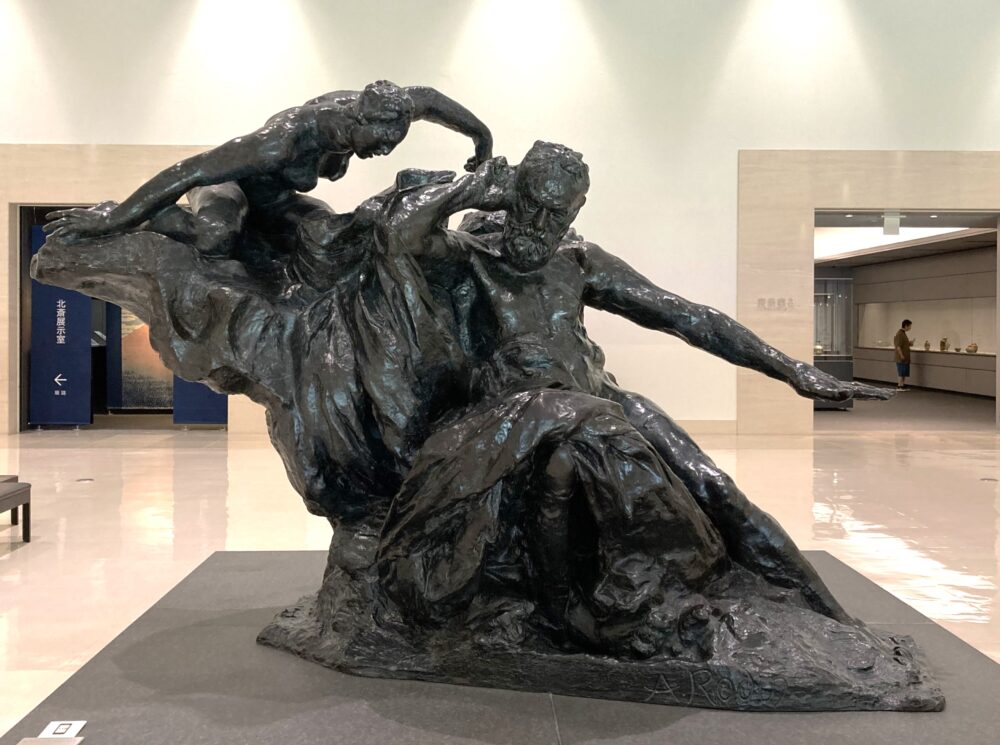
About This Work (Tap or Click to View)
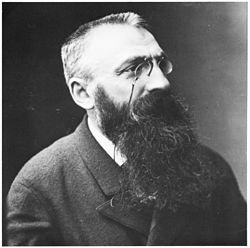
Rodin’s Tribute to the Great Writer Victor Hugo
This powerful bronze sculpture honors Victor Hugo, the legendary French author of Les Misérables and The Hunchback of Notre-Dame.
After Hugo’s death, a plan was made to build a monument for him in the Panthéon in Paris.
The commission was given to Auguste Rodin, who had already created a bust of Hugo during the writer’s lifetime in 1883.
Because Hugo disliked posing, Rodin observed him in everyday life — sketching repeatedly until he captured the writer’s true character.
This deep understanding of Hugo’s presence made Rodin the ideal artist for the memorial.
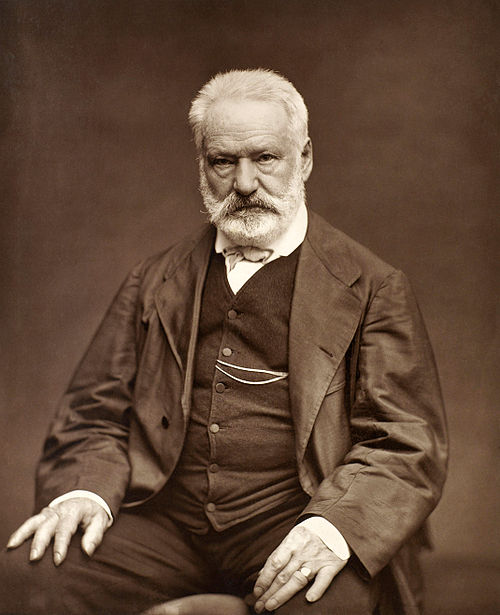
A Poet Surrounded by Spirits
Rodin’s Monument to Victor Hugo depicts the writer during his exile on the island of Guernsey, where he wrote some of his greatest works.
Hugo sits upon a rock, while gentle spirits appear behind him, whispering to his imagination.
He listens calmly, extending one hand as if to hold back the noise of the outside world.
Turning away from chaos and focusing instead on inner vision, poetry, and thought —
Rodin captured not just the likeness of Hugo, but his spiritual essence.
Though the monument was originally planned for the Panthéon, it was ultimately placed on Avenue Victor Hugo in Paris.
Quiet yet full of tension, this masterpiece embodies both strength and serenity.
Take a moment to stand before it at the Shimane Art Museum, and feel the soul of Hugo as Rodin saw him —
a man listening to the voices of inspiration beyond the noise of the world.
Take a Break by the Water — Shimane Art Museum and the Spirit of Hokusai
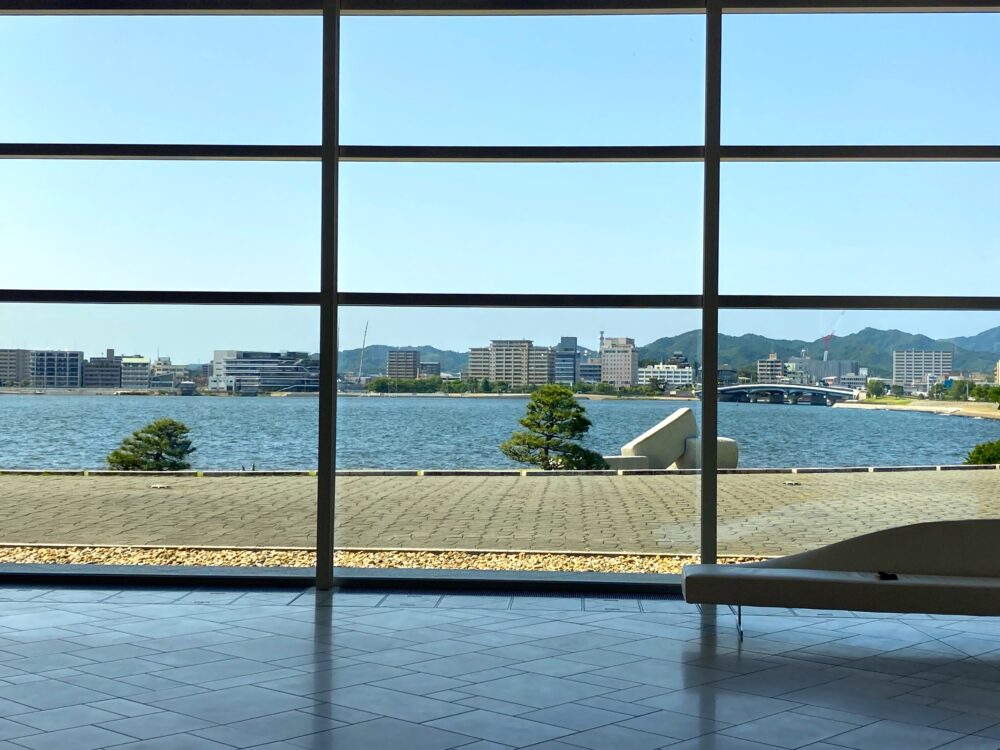
Located beside the peaceful Lake Shinji in western Japan, the Shimane Art Museum offers far more than its quiet setting might suggest. Inside, you’ll find an impressive lineup of masterpieces from both East and West.
From Monet, Courbet, and Chavannes to Hokusai’s Thirty-Six Views of Mount Fuji and Hiroshige’s Fifty-Three Stations of the Tokaido, the museum’s collection bridges cultures and centuries with remarkable quality.
After exploring the galleries, take a moment to relax in the first-floor lobby overlooking Lake Shinji. The view through the west-facing windows looks like a living painting — especially at sunset. Since the museum stays open until dusk, you can enjoy the golden glow of evening reflected on the water.
When you need a quiet escape from everyday life, this is the perfect place to slow down. The serene lake view and the museum’s rich collection of art will leave you feeling calm and inspired.
Shimane Art Museum – Visitor Information
Location: 1-5 Sodeshi-cho, Matsue, Shimane Prefecture









Comments